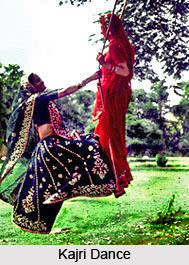Kajri dance is one of the most popular and well known forms of folk dance in Uttar Pradesh of India. Kajri dance is performed just before the arrival of the monsoons to express joy and happiness.
 History of Kajri Dance
History of Kajri Dance
Mirzapur is considered the real birth place of the Kajri dance. According to a folk tale of Mirzapur, King Kantit Naresh`s daughter Kajali loved her husband very much but she could not meet her husband throughout her life. Monsoon came still she couldn`t meet her husband. When the separation became unbearable she started crying at the feet of the Kajmal Goddess. These cries took the form of the popular Kajri songs. She remains alive through these songs.
The Style and Forms of Kajri Dance
Kajri dace is performed with the accompaniment of the charming `Jhula` lyrics or swing songs. The term Kajri possibly has been derived from the Hindi word Kajra, or Kohl which is a genre of semi-classical singing.
In Uttar Pradesh, Kajri dance is precisely performed in two forms. One type is performed on a performance platform and the other is sung by women on monsoon evenings. The latter type is known as `Dhunmuniya Kajri`.
The land of Uttar Pradesh experiences sizzling hot during summer and the only relief at that time is the arrival of black monsoon clouds that bring with them rain drenched with relief and great joy. To celebrate their arrival, women in the village sing songs and express joy for the upcoming monsoons bidding adieu to the scorching summer. They swing together singing enchanting songs in the village gardens.
Charles Doyley while giving an account of a dancing woman of Lucknow says that their dance postures and movements are well executed and graceful in nature. Although they lack variety in steps yet the complicated feet movements are remarkably accomplished.
Costumes of Kajri Dance
The dancers usually wear a tight fitting and short length blouse known as choli paired with a flared skirt. These cholis are short in length and there always remains a gap between the waistband of the skirt and the edge of the choli. They also put a dupatta over it which is tucked in the waist of the skirt and is draped around the head and shoulder. These dupattas are generally richly embroidered and feature decorative gold and silver thread in the edges. The skirt extends up to the ankles widening as it moves down with endless folds. The dancers complete the look by wearing heavy jewelleries. These jewelleries mainly consist of bangles, anklets, ear-rings, necklaces, and others. The Kajri dance closely resembles the dance pattern of the Kathak School.
Places and Persons Famous for Kajri Dance
Kajri dance is performed in various villages and towns of Uttar Pradesh and Bihar. Mirzapur, Banaras, Mathura, Allahabad are some of the places of Uttar Pradesh where Kajri dance is famous. The Bhojpur regions of Bihar also organises this dance form.
Some of the names of renowned persons who played key role in popularising Kajari dance are Pandit Channulal Mishra, Shobha Gurtu, Siddheshwari Devi, Girija Devi, and Rajan and Sajan Mishra.



















